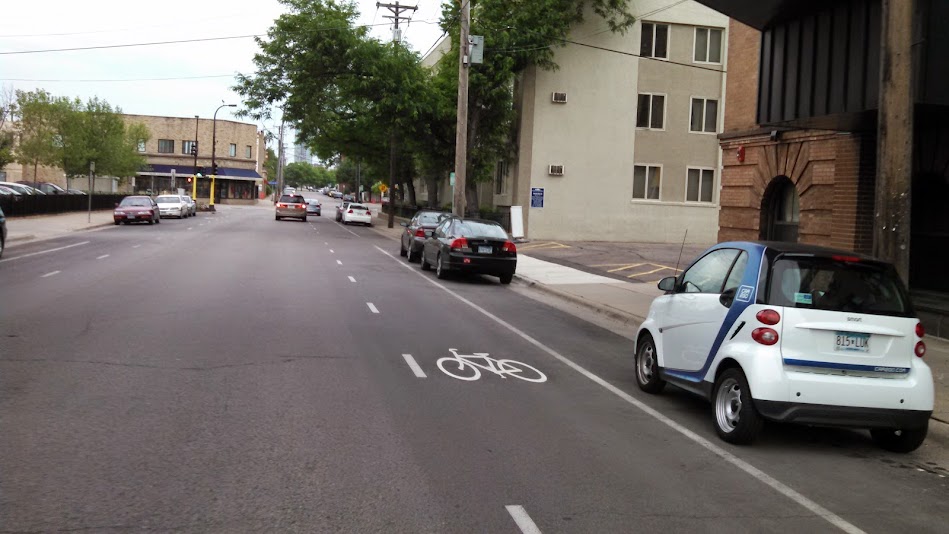The Manual of Uniform Traffic Control Devices requires the use of a center line in the following cases:
Standard:
09 Center line markings shall be placed on all paved urban arterials and collectors that have a traveled way of 20 feet or more in width and an ADT of 6,000 vehicles per day or greater. Center line markings shall also be placed on all paved two-way streets or highways that have three or more lanes for moving motor vehicle traffic.
09 Center line markings shall be placed on all paved urban arterials and collectors that have a traveled way of 20 feet or more in width and an ADT of 6,000 vehicles per day or greater. Center line markings shall also be placed on all paved two-way streets or highways that have three or more lanes for moving motor vehicle traffic.
Guidance:
10 Center line markings should be placed on paved urban arterials and collectors that have a traveled way of 20 feet or more in width and an ADT of 4,000 vehicles per day or greater. Center line markings should also be placed on all rural arterials and collectors that have a traveled way of 18 feet or more in width and an ADT of 3,000 vehicles per day or greater. Center line markings should also be placed on other traveled ways where an engineering study indicates such a need.
10 Center line markings should be placed on paved urban arterials and collectors that have a traveled way of 20 feet or more in width and an ADT of 4,000 vehicles per day or greater. Center line markings should also be placed on all rural arterials and collectors that have a traveled way of 18 feet or more in width and an ADT of 3,000 vehicles per day or greater. Center line markings should also be placed on other traveled ways where an engineering study indicates such a need.
11 Engineering judgment should be used in determining whether to place center line markings on traveled ways that are less than 16 feet wide because of the potential for traffic encroaching on the pavement edges, traffic being affected by parked vehicles, and traffic encroaching into the opposing traffic lane.
 |
| East 14th Street in Minneapolis has Advisory Bicycle Lanes |
Minneapolis has implemented advisory bike lanes on East 14th Street. Riding on this street, I found it worked well (it was off-peak travel times) because of the low traffic volumes and low speeds. In our six block ride along the street, we never encountered cars passing each other at the same time, so when a motor vehicle did need to pass me, the person passed with a very comfortable amount of space (likely due to the elimination of the center line).
 Advisory bike lanes or bike lanes without a centerline on a street (as shown at right) have been used sparingly in Portland. There has been some elimination of centerlines where the traffic volumes do not warrant the maintenance necessary to keep them marked. The volumes and the speeds are of interest. There's some interest in measuring before and after speeds, to determine whether the street is more comfortable for people on bikes.
Advisory bike lanes or bike lanes without a centerline on a street (as shown at right) have been used sparingly in Portland. There has been some elimination of centerlines where the traffic volumes do not warrant the maintenance necessary to keep them marked. The volumes and the speeds are of interest. There's some interest in measuring before and after speeds, to determine whether the street is more comfortable for people on bikes. |
| Street level view of NE 43rd Advisory Bicycle Lane in Portland, OR |
There is also a really nice summary of the topic and pictures on the Peter Furth inspired blog Sustainable Transportation Holland by Tom Bertulis, etal and an update in 2012 that included some dimensions from the CROW Manual. The 2012 report even got a copy of the Request to Experiment submitted to FHWA. The Request to Experiment was a summary of a number of innovative treatments that the City undertook as a part of their
Dutch Minimum Width using adjusted CROW values
|
Dutch Width According
to CROW manual |
US Minimum Width
| |
Bike-Car-Bike
|
5.15 m; 16' 11''
| 6.45 m; 21' 2'' | |
Car-Car-Bike
|
5.8 m; 19'
| 6.15 m; 20' 2'' | |
Bike-Car-Car-Bike
|
7.5 m; 24' 7''
| 7.3 m; 23' 11'' | |
Bike-Bus-Bus-Bike*
|
8.54 m; 28''
| 9 m; 29' 6'' |
The takeaway from this experience is that APBP is a great convener of ideas that should guide those involved with information on new facilities. This information can be used to move bicycle and pedestrian infrastructure forward. Interestingly enough during my research on the topic, APBP had a summary article based on some listerv discussion on Advisory Bike Lanes back in 2009.
It would be ideal to get information from the members of the listserv related to what are the most critical issues that should be in the next edition of the Manual of Uniform Traffic Control Devices. One of the challenges of APBP is to make sure that we are working with engineers that have access to available resources like this City of Minneapolis Request to Experiment (linked above). Yet, if only Minneapolis is implementing this sort of treatment, the treatment can be viewed as a singular interest that doesn't get widely adopted or considered for the MUTCD.
No comments:
Post a Comment